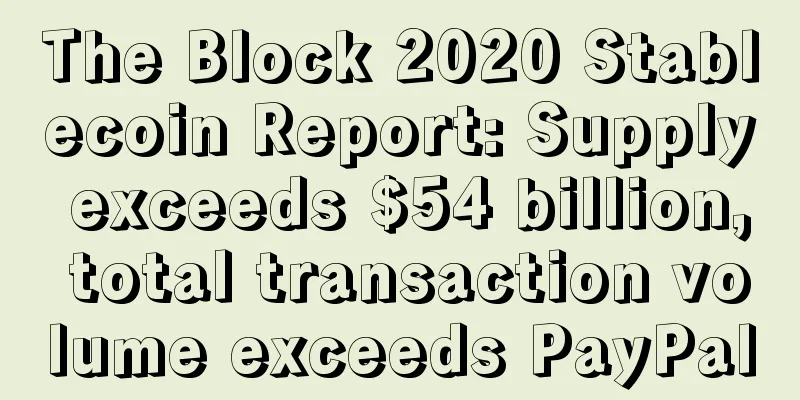The Block 2020 Stablecoin Report: Supply exceeds $54 billion, total transaction volume exceeds PayPal

|
By Larry Cermak, Head of Research at The Block Translation: Lu Jiangfei In the past year, the stablecoin market has achieved incredible growth, with the current supply exceeding $54 billion and the average monthly on-chain transaction volume reaching $380 billion. Recently, The Block released a 130-page stablecoin market report. The key content of the report is excerpted as follows: Since January 2020, many stablecoin business indicators have achieved huge growth, such as:
However, although various indicators have grown significantly, there are not enough products to support them. In fact, the main reasons for the surge in the stablecoin market last year are as follows:
In 2020, stablecoin transactions reached 110 million with a total transaction value of more than $1 trillion. In comparison, PayPal's transaction volume last year was 154 billion with a total transaction value of approximately $936 billion. From this we can clearly see the difference, in terms of the average transaction value, PayPal is about $60 per transaction, while stablecoins are more than $9,000. On the one hand, stablecoin transaction fees are indeed slightly higher; on the other hand, stablecoins do not have many other use cases (mainly trading) at present, so most stablecoin transactions are above $100. Among all stablecoin transactions, about 40% of the transaction amounts are between $100 and $1,000. At present, the cryptocurrency exchange Binance has the largest number of stablecoins. According to data at the end of January, the total amount of stablecoins held by Binance has reached nearly $10 billion. In addition, a large number of stablecoins are also locked in DeFi protocols such as Curve, Aave and Uniswap. About 40% of the stablecoin supply comes from exchanges, 11% comes from DeFi protocols, and the rest comes from wallets, OTC platforms, trading firms, etc. The following chart shows the geographical distribution of the two most popular stablecoins, USDT and USDC. USDT is most used in Asia, while USDC is most used in the United States. This is mainly because many Asian exchanges chose USDT stablecoin in the early days. The vast majority of stablecoins are pegged to fiat currencies and use fiat currencies as collateral, accounting for 96%. The reason for choosing to peg to fiat currencies is mainly because this method is the most scalable and the execution process is also very simple. As of the end of January, 70% of the stablecoin supply was on the Ethereum blockchain, 27% on the TRON blockchain, and another 3% on OMNI. There is a shocking data that currently 99% of the stablecoin supply is anchored to the US dollar. There are two main reasons for this: one is that traders still prefer the US dollar, and the other is that non-US dollar stablecoins are more difficult to cash out and the interest rate is relatively low. Tether is currently the most "market-dominant" stablecoin. Let's take a look at the relevant data:
|
<<: Data: 29% of British investors are encouraged to invest in Bitcoin by the bull market
Recommend
Bitcoin stabilizes and rebounds, will it continue to hit 28,000?
Author | Hashipi Analysis Team...
The face with horizontal lines on the root of the nose
The bridge of the nose is the area between the ey...
The target is more than tens of thousands of Bitcoins, why is Acchain so excited?
For the digital currency industry, the advantages...
Look at the faces of people who have prosperous children
If you have been married for many years but have ...
Know how to break down tasks so you don't get too stressed out
In fact, everyone will encounter some difficult t...
How lucky is a woman without earlobes?
Many people believe that earlobes are a symbol of...
What is the sign of a black forehead? Do people with black foreheads have bad luck?
People with black foreheads are prone to quarrels...
What does an extremely selfish and narcissistic person look like?
After experiencing the wave of the one-child poli...
Three Hangzhou network administrators were arrested for implanting a "mining" virus into Internet cafe computers
According to Tencent Technology, on July 31 this ...
Is the right hand palmistry good?
What is a broken palm? There are two types of bro...
Both Bitcoin and Ethereum are rising, so why isn’t Polkadot following the trend?
Today, Biden finally defeated Trump and became pr...
After the halving, how much will it cost to conduct a 51% attack on Bitcoin?
This article is from Crypto Briefing, original au...
Is a man with thin upper and lower lips lucky? Face analysis
Some boys have thin lips, some boys have thick li...
Bitcoin startup BitPesa sues Kenyan mobile payments giant Safaricom
According to Kenyan media the Daily Nation, on Tu...
Do people with pointy ears have bad luck?
"Any change in the five senses will lead to ...









